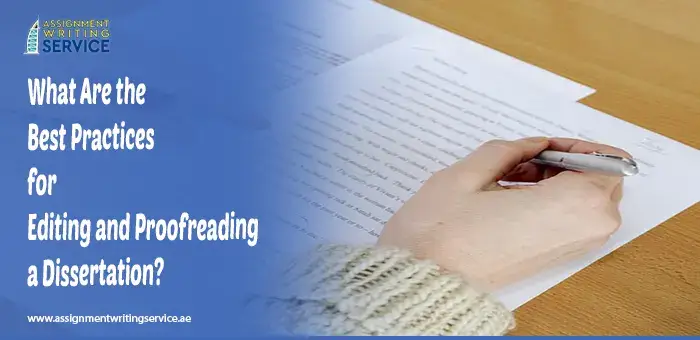Introduction
Revision and proofreading refer to the final processes that help present the research work professionally and free from minor errors. They assist in any way in stamping out the mistakes that your work might have, improving the clauses and paragraphs’ form and structure. Thus improving the solidity of your work generally.
Opt to Pause the Writing Before Editing
When you are through with writing the dissertation, clear all the material, before you start the process of editing it. Such a break enhances an individual’s focus when they go back to work; this makes it easier to identify errors or things that need to be corrected. Regardless of whether it is for a few days or a week. Such a period of detachment makes you come to the dissertation with fresh perspectives.
Start with Structural Editing
Organizing the chapters and sections of your dissertation: It is advisable to start editing your dissertation at the level of the global structures. Make sure that every segment of your paper is relevant and answers the question you posed in your thesis. Identify the holes in the argument or places where you might need more arguments or provide a better explanation.
Enhance Clarity and Coherence
Good presentation of data in written form is vital for the proper dissemination of findings to the public. Make sure that every paragraph has a topic sentence. And that the ideas in your paper transition smoothly from one paragraph to the next. This means using simple language and avoiding using many big and complicated words and phrases.
Check for Consistency
If there’s any virtue to be followed strictly in academic writing, then it is consistency. Ensure that the linguistic expressions you use are consistent in the kind of terminology, tone, and style that is being followed throughout the writing of the dissertation.
Focus on Accuracy
Completeness with your references, sources, and facts need to be correct. Reread all the statistical assumptions made, numbers used in the problem-solving, and tables constructed for confirmation. After the completion of the writing process, always check the in-text reference. And the reference list so that the sources used are correctly cited.
Be Aware of Words and Their Usage
Correct usage of language and grammar enhances the quality and presentation of the work done on a dissertation. Search for possible mistakes in parts of speech, tenses, and articles and the usage of proper subject-verb agreement. Preference should go to the active voice, and there should not be, as far as is feasible, unnecessary and empty passives. See that the given paragraphs have no long winding sentences. It is best not to use many words where few will suffice.
Utilize Editing Tools
Make use of technological enhancement in editing to correct the mistakes. The use of autograph tools, such as Grammarly, Hemingway, and ProWritingAid, enables one to identify errors. Such as grammar and the proper way of formulating sentences and to make writing more comprehensible.
Read Aloud
Writing and speaking about your dissertation, out loud, will help you spot errors you could not see when reading the text. It also extends a way to how you voice your arguments and ideas to ascertain that they are logical as well as understandable.
Seek Feedback
Suggestions coming from colleagues or professional editors can be great ideas. Other people can also provide new ideas and push towards the modification of certain weaknesses, present different solutions that could be applied, and inform you about mistakes you failed to notice. As the work of Young says, constructive criticism is one of the most useful tools in improving your dissertation’s quality. You can even opt for professional help via the Dissertation Editing Services.
Proofread in Stages
In cases like this, proofreading is quite efficient when divided into several sessions each with its finesse to explore. First, move through the text from beginning to end for big-picture issues and to catch all the gross misconceptions. Subsequently, it is advisable to arrange targeted proofreading meetings related to particular problems, for example, grammar and punctuation, citations, or formatting.
Use a Checklist
Develop a checklist that will guide you on some of the areas to proofread. The items may thus include a check for any typographical errors, checking on the citations, checking on the format used, and the content of figures/tables among other areas. A checklist is useful in making your work easier and systematically undertaking the proofreading.
Final Review
After making changes that you think are right for the document and proofreading the document, read the entire dissertation. First of all, the examiner pays attention to the general layout of the title page, abstract, table of contents, and other preliminary pages and checks if it complies with the specified standards and if there are no mistakes.
Conclusion
Proofchecking and copy editing are two very vital stages in the process of dissertation writing that play a major role in achieving consistency, accuracy, and professional quality in the final work. If one chooses a mechanical and methodical transition – going through the structural editing, guaranteeing the cohesion and coherence of the text, then through consistency and accuracy checking, and finishing with the language and grammar level – a high-standard dissertation must be prepared.
The strategies that will aid in checking for mistakes and enhancing work include editing tools, reading out the work, asking others to review, proofreading in segments, using a working checklist, and the final review. Adhering to the above best practices will assist you in presenting your research most positively, proving the effort and commitment you put into the project.


